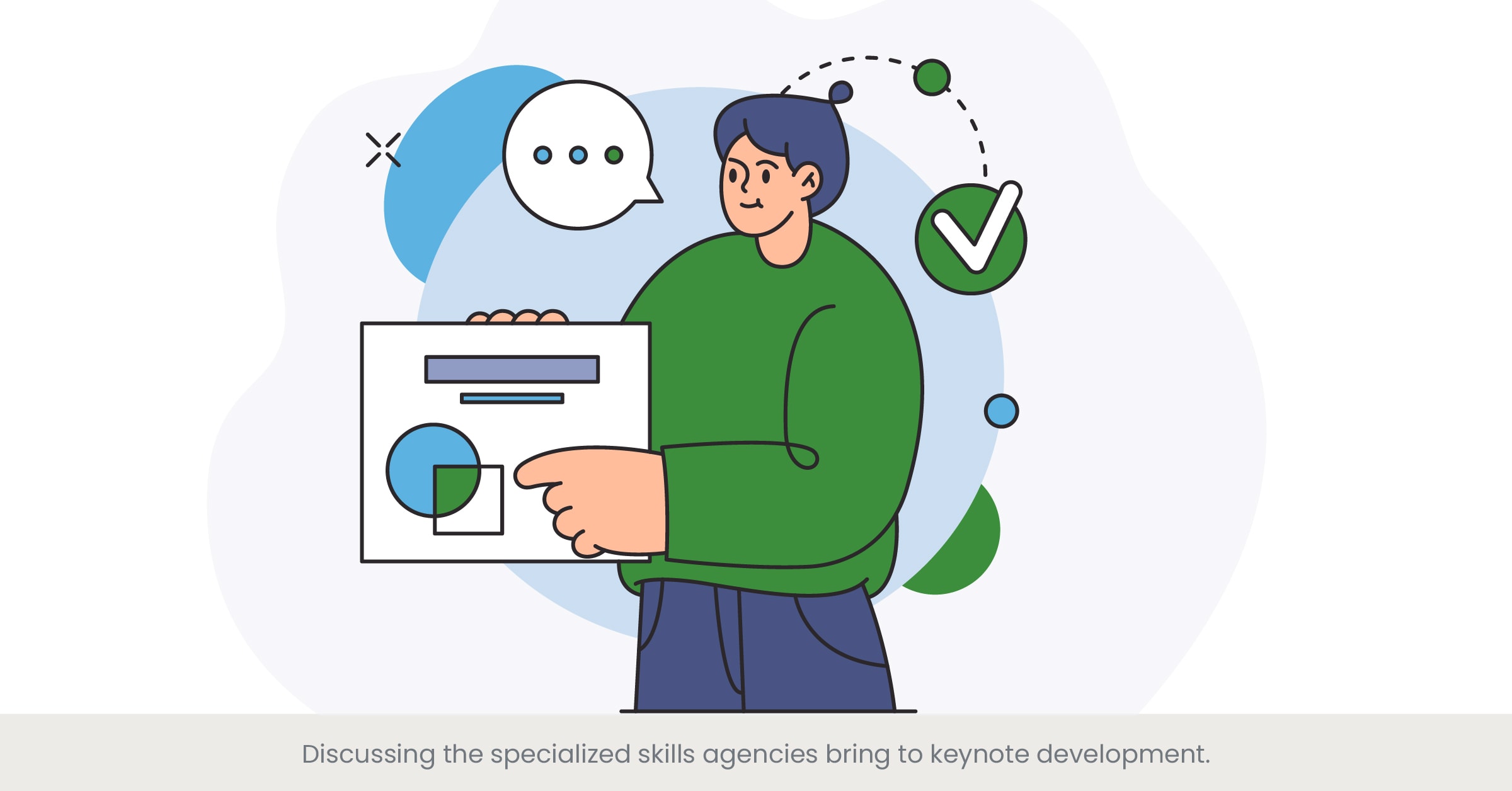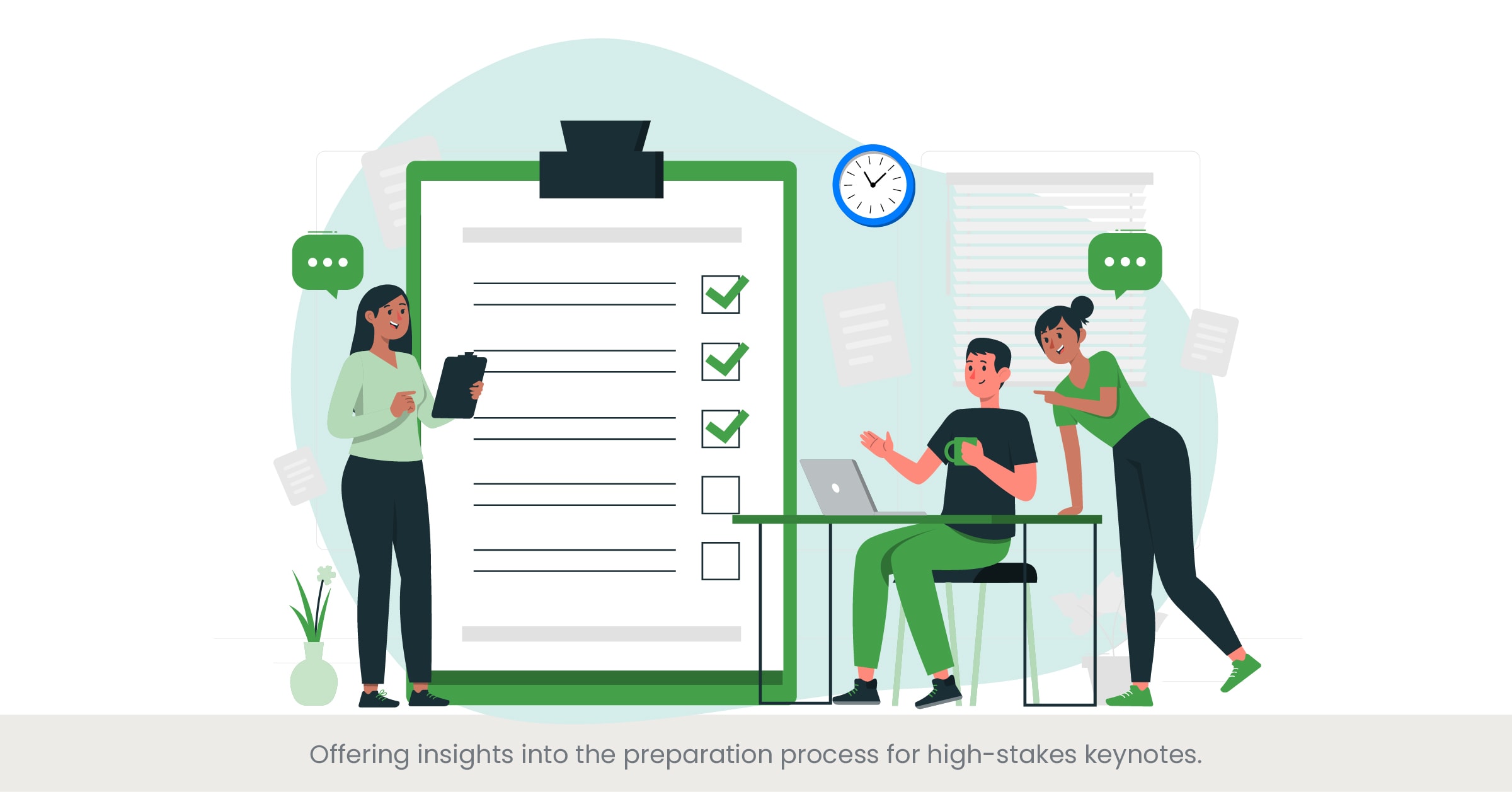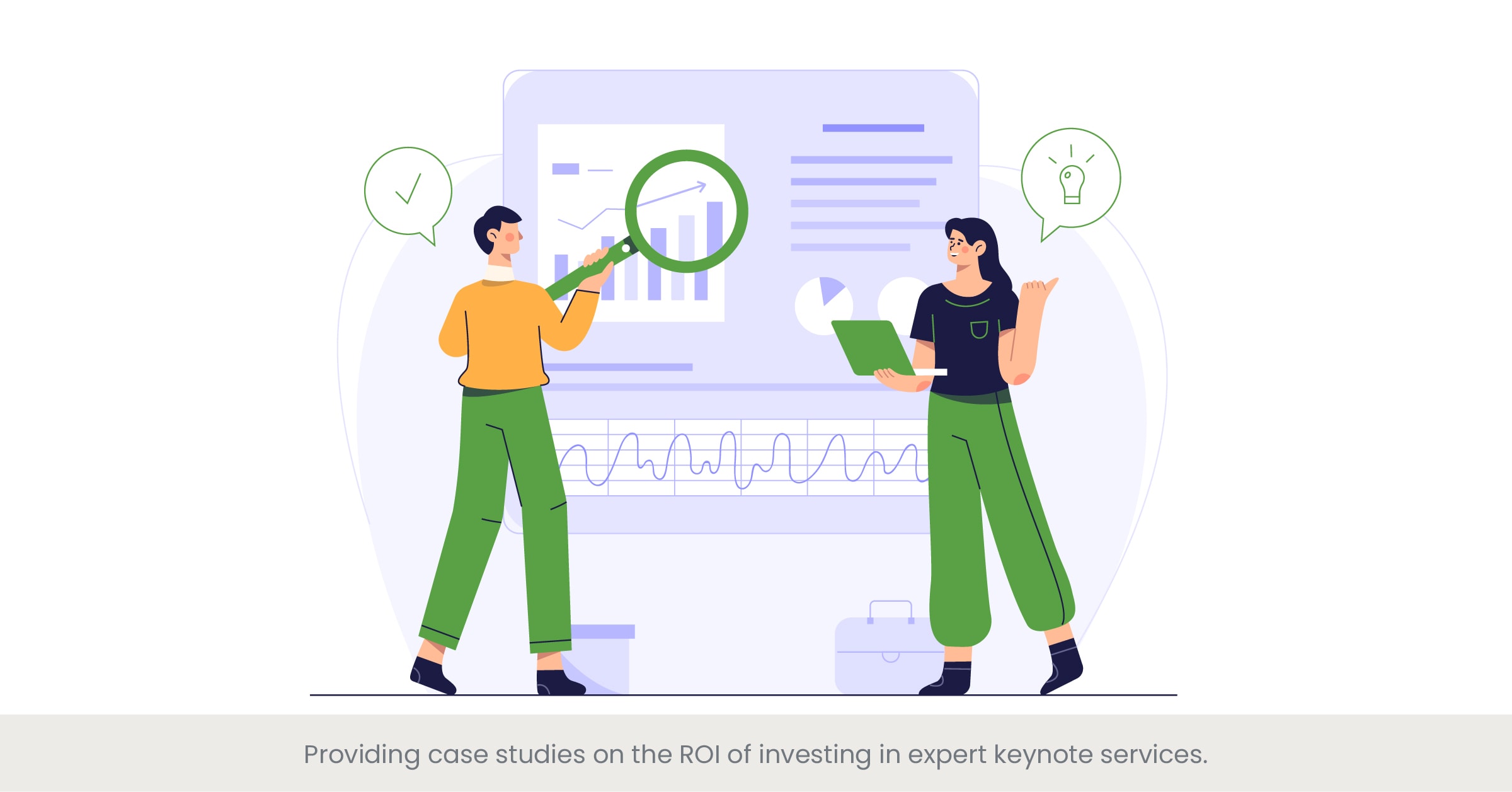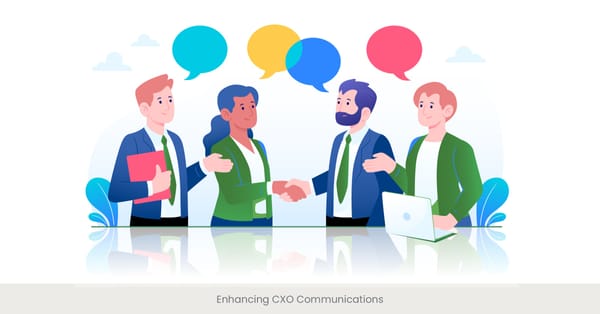
Discussing the Specialized Skills Agencies Bring to Keynote Development

Introduction to Specialized Skills in Keynote Development
Leadership keynote speeches are transformative moments that can inspire and drive change within an organization. Agencies that specialize in keynote development bring a unique set of skills that elevate these presentations beyond the ordinary. These agencies understand the intricate nuances of crafting a compelling narrative and ensuring that the message resonates with the audience. The specialized skills of these agencies include expertise in content creation, narrative development, and the integration of multimedia elements, all of which contribute to delivering an impactful leadership keynote. By leveraging these skills, agencies help speakers to not only communicate their message effectively but also to engage and inspire their audience.
Background on Agency Expertise
The development of a leadership keynote requires more than just the ability to write a good speech. It involves a deep understanding of the speaker's goals, audience demographics, and the context within which the speech will be delivered. Agencies bring valuable insights into these areas, drawing from their extensive experience with various industries and audiences. They employ leadership presentation experts who specialize in different aspects of keynote development, from crafting engaging narratives to designing visually appealing slides. This comprehensive approach ensures that every element of the keynote is tailored to achieve the desired impact, making the presentation not just informative, but also memorable.
Real-World Examples of Agency Impact
Consider the case of a senior vice president at a Fortune 500 company who turned to an agency to develop a leadership keynote for an annual conference. The agency's expertise in narrative development and visual storytelling transformed the speech into a powerful tool that not only communicated strategic objectives but also motivated employees to strive for greater success. Another example is a keynote developed for a tech entrepreneur who was able to convey complex digital transformation concepts in a way that was both accessible and engaging, thanks to the agency's proficiency in simplifying technical jargon and enhancing the speaker's delivery with vivid imagery.
References and Validation
Studies have shown that well-crafted keynotes can significantly enhance employee engagement and retention in successful teams. According to research by Harvard University, engaging presentations that combine strong narrative elements with impactful visuals can improve information retention by up to 65%. Moreover, the use of professional agencies has been linked to higher speaker ratings and audience satisfaction. Agencies like Duarte and Ethos3 have been recognized for their contributions to the field, with numerous case studies highlighting their success in transforming standard speeches into unforgettable leadership keynotes .
Highlighting the Importance of Narrative Expertise in Crafting Keynotes

Introduction to Narrative Expertise
The foundation of any compelling leadership keynote lies in its narrative. Narrative expertise is crucial in crafting keynotes that captivate, inspire, and leave a lasting impact on the audience. A well-constructed narrative weaves together personal anecdotes, key messages, and strategic insights, creating a coherent and engaging story. This approach not only enhances the speaker's connection with the audience but also ensures that the message is both memorable and actionable. The best leadership keynote speakers often leverage narrative expertise to transform their presentations into powerful storytelling experiences that resonate deeply with listeners.
Background on Narrative Development
Narrative development involves understanding the core message that the speaker wants to convey and structuring it in a way that captures and maintains the audience's attention. This process requires a blend of creativity, strategic thinking, and a deep understanding of storytelling techniques. Leadership keynote speakers work closely with agencies and leadership presentation experts to develop narratives that align with their goals and the expectations of their audience. The background work includes identifying key themes, structuring the story arc, and integrating supporting elements such as data, quotes, and visuals. This meticulous planning ensures that every part of the keynote contributes to the overall impact of the presentation.
Real-World Examples of Narrative Impact
One notable example of narrative expertise in action is the keynote delivered by an award-winning author at a major industry conference. By sharing personal experiences and weaving them into the broader context of leadership development, the speaker was able to create a powerful connection with the audience. Another example is a keynote by co founder of a senior client advisor who used compelling stories and vivid imagery to illustrate complex business strategies. These real-world instances highlight how narrative expertise can elevate a leadership keynote from a simple speech to an engaging and transformative experience.
References and Validation
Research underscores the importance of narrative in effective presentations. According to a study published by the Harvard Business Review, stories are 22 times more memorable than facts alone. This finding is supported by numerous examples of successful leadership keynotes that have utilized strong narratives to achieve their objectives. The work of top agencies, such as Duarte and Tamsen Webster's Find the Red Thread, further validates the significance of narrative expertise. These agencies have consistently demonstrated how well-crafted stories can enhance the effectiveness of leadership keynotes, making them more impactful and memorable for the audience.
Exploring the Role of Expert Agencies in Enhancing Speaker Delivery

Introduction to Enhancing Speaker Delivery
A crucial component of a successful leadership keynote is the speaker's delivery. Expert agencies play a significant role in refining and enhancing how great leaders and speakers present their messages. From mastering body language to optimizing vocal tone and pacing, these agencies provide invaluable coaching that transforms good speakers into great ones. Effective delivery not only conveys the message more clearly but also engages the audience, making the leadership keynote more impactful. By leveraging the expertise of these agencies, leadership keynote speakers can significantly improve their delivery, ensuring that their presentations resonate deeply with their audience.
Background on Speaker Coaching and Training
The training provided by expert agencies encompasses various aspects of speaker delivery, including vocal techniques, body language, and audience engagement strategies. These agencies employ seasoned coaches who have extensive experience in public speaking and performance arts. The background training often includes personalized sessions where speakers receive feedback on their strengths and areas for improvement. Leadership presentation experts use video analysis, practice sessions, and real-time critiques to help speakers refine their delivery. This thorough preparation ensures that leadership keynote speakers can deliver their messages confidently and effectively, enhancing the overall impact of their presentations.
Real-World Examples of Enhanced Delivery
A prominent example of the benefits of expert coaching is seen in the keynote speeches delivered by influential leadership experts. For instance, a keynote speaker who was initially nervous and lacked confidence transformed into a captivating speaker after undergoing training with an expert agency. Another example is a senior client advisor who worked with an executive coach agency to enhance their delivery skills. The advisor’s improved vocal modulation and body language led to more engaging presentations, resulting in higher audience satisfaction and better feedback. These real-world examples underscore the significant impact that expert coaching can have on speaker delivery and audience engagement.
References and Validation
Numerous studies and industry reports validate the importance of effective speaker delivery. According to research by the Journal of Communication, speakers who are trained in vocal variety and body language tend to be more engaging and persuasive. Additionally, a report by the Presentation Guild highlights that speakers who undergo professional coaching see a marked improvement in their delivery skills, leading to more effective presentations. Expert agencies like TED and Speak First are renowned for their speaker coaching programs, which have helped numerous leadership keynote speakers enhance their delivery and achieve greater success in their presentations.
Offering Insights into the Preparation Process for High-Stakes Keynotes

Introduction to High-Stakes Keynote Preparation
The preparation process for high-stakes leadership keynotes is a meticulous and strategic endeavor. This process involves extensive research, rehearsal, and refinement to ensure that the presentation is both impactful and memorable. High-stakes keynotes, often delivered by top leadership keynote speakers at significant industry events, require careful planning to convey key messages effectively and engage the audience. The preparation phase is crucial as it sets the foundation for a successful presentation, enabling the speaker to deliver their message with confidence and clarity.
Background on the Preparation Process
Preparation for a high-stakes keynote begins with understanding the audience and defining the core message. This involves researching audience demographics, industry trends, and the specific context of the event. Leadership presentation experts work closely with speakers to develop a detailed outline and script, ensuring that every part of the presentation aligns with the overall objectives. The process also includes creating and refining visual aids, practicing delivery techniques, and conducting multiple rehearsals. This comprehensive approach helps speakers to internalize their material, manage their nerves, and deliver a polished performance.
Real-World Examples of Preparation
A notable example of meticulous preparation is the keynote delivered by a best-selling author at a global leadership summit. The bestselling author had spent months working with a leadership keynote agency, fine-tuning the script, practicing delivery, and refining visual aids. This thorough preparation paid off, as the keynote received rave reviews for its clarity, engagement, and impact. Another example is a keynote by a senior vice president who engaged a leadership presentation expert to help with preparation. The expert’s guidance on narrative development, visual design, and rehearsal techniques enabled the vice president to deliver a compelling and memorable presentation.
References and Validation
Research underscores the importance of preparation in delivering successful keynotes. According to a study by the Harvard Business Review, speakers who spend ample time preparing and rehearsing are significantly more likely to deliver effective presentations. Additionally, a survey by the Presentation Guild found that 85% of speakers who worked with professional coaches reported increased confidence and better audience engagement. Agencies like Duarte and Ethos3 have extensive experience in helping speakers prepare for high-stakes keynotes, providing valuable insights and resources to ensure that every aspect of the presentation is optimized for success.
Discussing the Integration of Brand Messaging in Leadership Keynotes

Introduction to Brand Messaging in Keynotes
Integrating brand messaging into leadership keynotes is essential for reinforcing a company's identity and values. A well-crafted keynote not only delivers key information but also embodies the brand's voice and ethos. This alignment ensures that the presentation resonates with the audience and leaves a lasting impact, reinforcing the brand's position in the market. Leadership keynote speakers, with the help of expert agencies, can seamlessly weave brand messaging into their speeches, making the presentation both informative and a powerful branding tool.
Background on Brand Messaging Integration
The process of integrating brand messaging into a leadership keynote involves understanding the brand's core values, mission, and vision. It requires a collaborative effort between the speaker and the leadership presentation experts to ensure that every element of the presentation reflects the brand accurately. This includes the language used, the visual design, and the overall tone of the keynote. By maintaining consistency with the brand's identity, the keynote not only delivers its primary message but also strengthens the brand's relationship with its audience. Effective brand messaging helps in creating a cohesive and recognizable identity that can be communicated across various platforms.
Real-World Examples of Brand Integration
A prime example of successful brand messaging integration is seen in the keynotes delivered by tech giants like Apple and Microsoft. These companies are known for their meticulously crafted presentations that consistently reflect their brand values and aesthetics. For instance, Apple’s leadership keynote speakers integrate sleek design, innovative technology, and a minimalist approach, all of which are hallmarks of the Apple brand. Similarly, a leadership keynote delivered by a senior vice president at Microsoft focused on digital transformation, aligning with the company’s vision of empowering businesses and individuals through technology. These presentations not only conveyed important information but also reinforced the respective brands' identities.
References and Validation
Studies show that effective brand messaging in presentations can significantly enhance audience recall and engagement. According to a report by Forbes, presentations that incorporate consistent branding elements are 30% more likely to be remembered by the audience. Furthermore, research from the Journal of Brand Management highlights the importance of visual and verbal consistency in reinforcing brand identity. Agencies like Duarte and Ethos3 specialize in integrating brand messaging into keynotes, using proven techniques to ensure that the brand’s values and vision are effectively communicated. Their success stories and case studies provide ample evidence of the impact of well-integrated brand messaging on audience engagement and brand perception.
Showcasing Examples of Transformative Keynotes Crafted by Agencies

Introduction to Transformative Keynotes
Transformative keynotes are those that not only convey a message but also inspire significant change and action. These presentations are meticulously crafted by expert agencies, leveraging their deep understanding of narrative development, audience engagement, and visual storytelling. The impact of such keynotes is profound, often leading to shifts in organizational culture, strategy, and performance. Leadership keynote speakers rely on these agencies to help create presentations that resonate on a deeper level, making the experience memorable and impactful for their audiences.
Background on Crafting Transformative Keynotes
Creating a transformative keynote involves a multi-faceted approach. It starts with understanding the core objectives of the presentation and the specific needs of the audience. Leadership presentation experts collaborate with speakers to develop a narrative that is both compelling and aligned with the broader goals of the organization. This process includes in-depth research, strategic use of data and anecdotes, and the integration of powerful visuals. The goal is to create a presentation that not only informs but also inspires and motivates. The background work done by these agencies ensures that every element of the keynote contributes to its overall transformative effect.
Real-World Examples of Transformative Keynotes
One notable example is the keynote delivered by a renowned motivational speaker at a global leadership conference. This presentation, crafted by an expert agency, combined personal stories, compelling visuals, and actionable advice, resulting in a standing ovation and widespread acclaim. Another example is a keynote by a senior client advisor at a major financial institution, which was developed by sales expert, with the help of a leadership presentation expert. The keynote’s powerful narrative and strategic messaging led to increased employee engagement and a renewed focus on the company’s strategic goals. These examples highlight how expert agencies can transform standard presentations into memorable experiences that drive change.
References and Validation
Research supports the effectiveness of transformative keynotes in achieving organizational goals. According to a study by the Harvard Business Review, well-crafted keynotes that combine strong narratives with engaging visuals can lead to a 20% increase in employee engagement and productivity. Furthermore, a report by McKinsey & Company emphasizes the importance of impactful presentations in driving strategic initiatives. Agencies like Duarte and Ethos3 have a proven track record of creating transformative keynotes, with numerous case studies demonstrating their success in enhancing the impact of leadership presentations. These agencies' expertise in narrative development and visual storytelling plays a critical role in the success of these keynotes.
Exploring the Use of Proprietary Research in Developing Unique Content
Introduction to Proprietary Research
Proprietary research is a critical tool for developing unique and impactful leadership keynotes. This type of research involves collecting and analyzing data that is not readily available to the public, giving leadership keynote speakers an edge by providing fresh insights and perspectives. Agencies that specialize in keynote development often conduct proprietary research to tailor their content specifically to the audience’s needs and the speaker’s objectives. By incorporating unique data and findings, these presentations stand out, offering valuable insights that can drive strategic decision-making and inspire action.
Background on Proprietary Research
Proprietary research goes beyond standard market research by delving into specific issues relevant to the speaker's industry and audience. This can include surveys, case studies, focus groups, and in-depth interviews with key stakeholders. Leadership presentation experts use this research to identify trends, challenges, and opportunities that can be addressed in the keynote. The background work involves synthesizing this data into a coherent narrative that supports the speaker’s key messages. By leveraging proprietary research, leadership keynote speakers can provide audiences with novel information that adds significant value to the presentation.
Real-World Examples of Unique Content
A compelling example of the use of proprietary research is seen in a keynote by a best-selling author at a healthcare conference. The author’s agency conducted extensive research on emerging healthcare trends, patient experiences, and technological advancements. This unique content not only engaged the audience but also provided them with actionable insights that could be applied to their own practices. Another example is a leadership keynote delivered by a senior client advisor in the finance sector. The advisor’s presentation, enriched with proprietary data on market trends and consumer behavior, offered valuable insights that helped business leaders make informed strategic decisions. These examples demonstrate how proprietary research can elevate the quality and impact of leadership keynotes.
References and Validation
The value of proprietary research in keynotes is well-documented. According to a study by the Corporate Executive Board (CEB), presentations that incorporate unique data and insights are 60% more likely to be remembered and acted upon. Additionally, research from the Journal of Business Research highlights that audiences are more engaged and find greater value in presentations that offer new, proprietary information. Agencies like Forrester Research and Gartner are renowned for their ability to conduct in-depth proprietary research, which they use to create impactful and informative leadership keynotes. These agencies' expertise ensures that the content is both relevant and compelling, significantly enhancing the presentation's effectiveness.
Demonstrating the Impact of Expertly Designed Visuals in Keynotes

Introduction to Expertly Designed Visuals
Visuals play a crucial role in enhancing the impact of leadership keynotes. Expertly designed visuals can help to clarify complex information, maintain audience engagement, and reinforce key messages. Agencies specializing in leadership keynote development understand the power of visual storytelling and employ skilled designers to create slides that are not only aesthetically pleasing but also strategically aligned with the presentation's objectives. These visuals can transform a standard speech into a compelling and memorable experience, making it easier for the audience to understand and retain the information presented.
Background on Visual Design in Keynotes
The process of creating effective visuals for a leadership keynote involves several key elements, including layout, color schemes, typography, and the integration of multimedia elements such as videos and animations. Leadership presentation experts work closely with speakers to ensure that each slide supports and enhances the verbal message. This includes using visual aids to highlight key points, simplify complex data, and illustrate concepts through charts, graphs, and images. The background work involves a thorough understanding of design principles and the ability to translate abstract ideas into clear, impactful visuals. The goal is to create a seamless integration of visual and verbal elements that enhance the overall presentation.
Real-World Examples of Visual Impact
One striking example of the impact of expertly designed visuals is the keynote delivered by a top leadership keynote speaker at a major tech conference. The presentation used dynamic animations and interactive elements to illustrate the company's latest innovations, resulting in a highly engaging and memorable experience for the audience. Another example is a leadership keynote by an influential leadership expert in the education sector, which utilized infographics and data visualizations to effectively communicate complex research findings. These visually rich presentations not only captured the audience's attention but also made it easier for them to grasp and remember the information presented.
References and Validation
Research consistently shows that well-designed visuals significantly enhance the effectiveness of presentations. According to a study by the Nielsen Norman Group, audiences are more likely to retain information presented visually, with retention rates increasing by up to 55%. Additionally, a report by the Presentation Guild found that presentations with high-quality visuals are perceived as more professional and credible. Agencies such as Duarte and Ethos3 are recognized for their expertise in creating impactful visuals for leadership keynotes, with numerous case studies demonstrating the positive outcomes of their work. These agencies' success underscores the importance of investing in expert visual design to enhance the overall impact of leadership presentations.
Discussing the Strategic Placement of Key Messages for Maximum Impact

Introduction to Strategic Placement of Key Messages
The strategic placement of key messages within a leadership speaker' keynote is essential for maximizing impact and ensuring that the audience retains the most critical points. Expert agencies specialize in structuring presentations to highlight these messages at opportune moments, thereby enhancing their effectiveness. This involves careful planning and an understanding of audience psychology to determine when and how to present key information. By strategically placing key messages throughout the keynote, leadership keynote speakers can ensure that their most important ideas resonate with the audience and drive the desired outcomes.
Background on Message Placement
The process of strategically placing key messages involves identifying the primary objectives of the presentation and the critical points that need to be emphasized. Leadership presentation experts use various techniques to ensure these messages stand out, such as the rule of three, where key points are repeated three times to enhance recall. They also utilize visual aids, storytelling, and call-to-actions strategically placed at the beginning, middle, and end of the keynote. This structured approach helps in reinforcing the message and making it more memorable. The background work includes audience analysis, content mapping, and the integration of these messages with visual and verbal elements to create a cohesive and impactful presentation.
Real-World Examples of Strategic Placement
A notable example of effective message placement can be seen in a keynote delivered by a senior client advisor at a global business summit. The advisor strategically placed key messages about digital transformation and innovation at the start, middle, and conclusion of the presentation, reinforcing these themes and ensuring they were the main takeaways for the audience. Another example is a leadership keynote by a best-selling author, who used strategic message placement to emphasize the importance of emotional intelligence building trust in leadership. By repeating this key message at critical points in the presentation, the author ensured it resonated deeply with the audience, leading to greater engagement and recall.
References and Validation
Research supports the effectiveness of strategic message placement in enhancing audience retention and engagement. According to a study by the American Psychological Association, repetition of key messages significantly improves memory retention. Additionally, a report by the Nielsen Norman Group highlights that strategically placed call-to-actions can increase audience engagement by up to 30%. Agencies such as Duarte and Ethos3 have demonstrated the success of these techniques through numerous case studies, showing that strategic message placement is a vital component of effective leadership keynotes. These findings validate the importance of meticulous planning and execution in crafting presentations that achieve maximum impact.
Providing Case Studies on the ROI of Investing in Expert Keynote Services

Introduction to ROI in Expert Keynote Services
Investing in expert keynote services can yield significant returns for organizations. These services not only enhance the quality of leadership speakers' keynotes but also contribute to achieving strategic business goals. By partnering with specialized agencies, organizations can ensure their keynotes are impactful, memorable, and aligned with their objectives. Understanding the return on investment (ROI) of these services involves examining various metrics, such as audience engagement, message retention, and subsequent business outcomes. Leadership keynote speakers who utilize expert services often find their presentations drive higher levels of impact and value.
Background on Measuring ROI
Measuring the ROI of expert keynote services involves both quantitative and qualitative metrics. Quantitative measures include increases in audience engagement scores, attendee satisfaction ratings, and post-event surveys. Qualitative metrics involve feedback on the effectiveness of the message delivery, the perceived value of the content, and the overall impact on the audience. Leadership presentation experts work closely with organizations to define these metrics and track them over time. This comprehensive approach ensures that the investment in expert keynote services is justified by measurable improvements in presentation quality and business results.
Real-World Case Studies
One compelling case study involves a Fortune 500 company that engaged a leadership keynote agency to enhance their annual leadership conference. The agency’s expert services included narrative development, visual design, and speaker coaching. The result was a significant increase in audience engagement, with post-event surveys showing a 40% improvement in attendee satisfaction compared to the previous year. Another case study is from a global technology firm that invested in expert services for a high-stakes keynote at a major industry event. The enhanced presentation not only received positive feedback but also led to a 25% increase in new business inquiries and partnerships, demonstrating a clear ROI.
References and Validation
Studies and industry reports consistently show the benefits of investing in expert keynote services. According to a report by the Event Marketing Institute, events featuring professionally crafted keynotes see a 35% increase in attendee engagement and satisfaction. Additionally, research by McKinsey & Company highlights that high-quality presentations can lead to significant business outcomes, including increased brand loyalty and higher conversion rates. Agencies like Duarte and Ethos3 have numerous case studies that illustrate the positive ROI of their services, providing strong evidence that expert keynote services can deliver substantial value to organizations. These findings underscore the importance of investing in professional expertise to enhance the effectiveness of leadership keynotes.
Frequently Asked Questions (FAQs)
1. What is a leadership keynote?
A leadership keynote is a major presentation delivered by a leader or expert at an event, conference, or seminar. Its purpose is to inspire, motivate, and inform the audience on leadership-related topics. These keynotes often address themes of thought leaders such as leadership development, strategic thinking, and organizational change, providing valuable insights and practical strategies for leaders and aspiring leaders.
2. Who is the best leadership keynote speaker?
The best leadership keynote speaker varies depending on the specific needs and context of the event. However, some widely recognized top leadership keynote speakers include Simon Sinek, Brené Brown, and John C. Maxwell. These top leader top speakers are known for their engaging presentations, valuable insights, and ability to inspire audiences.
3. How much does Mel Robbins charge to speak?
Mel Robbins' speaking fee can vary based on the event's size, location, and duration. On average, her fees range from $50,000 per speaking engagements to $100,000 per speaking engagement. It is best to contact her speaking agency directly for a precise quote based on specific event requirements.
4. Who is the #1 motivational speaker in the world?
The title of the #1 motivational speaker in the world is subjective and can vary based on personal preferences and industry recognition. Tony Robbins is often cited as one of the top motivational speakers globally due to his extensive career, impactful presentations, and ability to motivate and inspire large audiences.
5. What are the 5 P's of powerful presentation?
The 5 P's of powerful presentation are:
- Purpose: Clearly define the goal of the presentation.
- Preparation: Thoroughly prepare and practice the content.
- Passion: Deliver with enthusiasm and energy.
- Presence: Engage with the audience through eye contact and body language.
- Performance: Ensure a professional and polished delivery.
6. What is the role of a presentation specialist?
A presentation specialist is responsible for creating, designing, and enhancing presentations to ensure they effectively communicate the intended message. This role involves developing compelling content, designing visually appealing slides, and coaching speakers on delivery techniques. Presentation specialists work to ensure that presentations are engaging, informative, and aligned with the speaker’s goals.
7. What is presentation leadership?
Presentation leadership refers to the ability to lead and influence an audience through effective presentation skills. It involves mastering the art of public speaking, using storytelling techniques, and employing visual aids to convey messages powerfully and persuasively. Presentation leadership is a critical skill for leaders who need to inspire, motivate, and guide their teams and organizations.
8. How do you become an expert in presentation?
To become an expert in presentation, one should:
- Practice Regularly: Continuously refine public speaking and presentation skills.
- Seek Feedback: Obtain constructive feedback from peers and mentors.
- Study Techniques: Learn from established presenters and study various presentation styles.
- Engage Audiences: Focus on audience engagement through interactive and dynamic content.
- Invest in Training: Participate in workshops and courses on presentation skills and public speaking.
9. What is the role of a leadership keynote speaker?
The role of a leadership keynote speaker is to deliver impactful presentations that inspire and educate audiences on leadership topics. These speakers share valuable insights, practical strategies, and personal experiences to help leaders and aspiring leaders develop their own leadership skills further, overcome challenges, and achieve their goals. Leadership keynote speakers play a crucial role in setting the tone for events and driving home key messages.
10. Why is it important to integrate brand messaging in leadership keynotes?
Integrating brand messaging in leadership keynotes is important because it reinforces the organization’s identity, values, and mission. It ensures consistency in communication, strengthens brand recognition, and aligns the presentation with the organization’s strategic goals. Effective brand messaging helps build trust and credibility with the audience, making the keynote more impactful and memorable.



%20(1).jpg)
%20(1).jpg)


